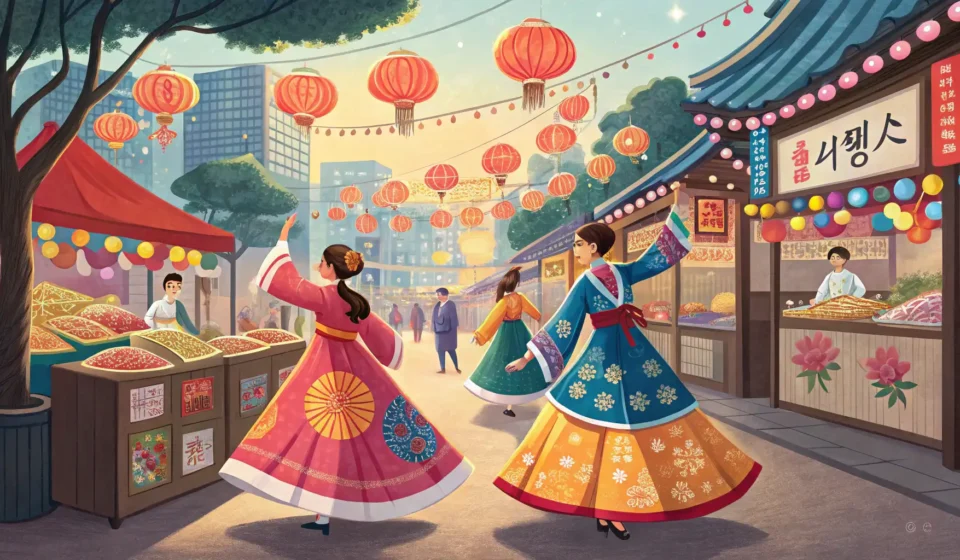
Asking About Traditional Dance at a Street Fair in Korean
Experiencing a local street fair or festival in Korea often includes vibrant traditional dance performances. This guide provides essential Korean phrases for tourists wanting to ask locals about the dances they are witnessing, helping you engage more deeply with Korean culture during your visit.
Table Of Content
Core Expression
-
Expression: 이 춤은 뭐예요?
Pronunciation: i chum-eun mwo-ye-yo?
Meaning: What is this dance?
Basic Questions at the Fair
-
Expression: 안녕하세요.
Pronunciation: an-nyeong-ha-se-yo.
Meaning: Hello. (Formal) -
Expression: 실례합니다.
Pronunciation: sil-lye-ham-ni-da.
Meaning: Excuse me. -
Expression: 이 춤 이름이 뭐예요?
Pronunciation: i chum i-reum-i mwo-ye-yo?
Meaning: What is the name of this dance? -
Expression: 이건 무슨 행사예요?
Pronunciation: i-geon mu-seun haeng-sa-ye-yo?
Meaning: What kind of event is this? -
Expression: 이 춤은 언제 시작했어요?
Pronunciation: i chum-eun eon-je si-jak-haess-eo-yo?
Meaning: When did this dance start? -
Expression: 공연은 언제 끝나요?
Pronunciation: gong-yeon-eun eon-je kkeut-na-yo?
Meaning: When does the performance end? -
Expression: 사진 찍어도 돼요?
Pronunciation: sa-jin jjik-eo-do dwae-yo?
Meaning: May I take a picture? -
Expression: 여기 앉아도 돼요?
Pronunciation: yeo-gi an-ja-do dwae-yo?
Meaning: May I sit here? -
Expression: 이 춤은 전통 춤인가요?
Pronunciation: i chum-eun jeon-tong chum-in-ga-yo?
Meaning: Is this a traditional dance? -
Expression: 정말 멋있네요!
Pronunciation: jeong-mal meos-iss-ne-yo!
Meaning: It’s really cool/amazing! -
Expression: 감사합니다.
Pronunciation: gam-sa-ham-ni-da.
Meaning: Thank you. -
Expression: 이 축제 이름이 뭐예요?
Pronunciation: i chuk-je i-reum-i mwo-ye-yo?
Meaning: What is the name of this festival?
Asking for More Details About the Dance
-
Expression: 이 춤은 어떤 의미가 있어요?
Pronunciation: i chum-eun eo-tteon ui-mi-ga iss-eo-yo?
Meaning: What meaning does this dance have? -
Expression: 이 춤은 어디에서 유래했어요?
Pronunciation: i chum-eun eo-di-e-seo yu-rae-haess-eo-yo?
Meaning: Where did this dance originate from? -
Expression: 주로 언제 이 춤을 춰요?
Pronunciation: ju-ro eon-je i chum-eul chwo-yo?
Meaning: When is this dance usually performed? -
Expression: 저 의상은 무엇을 나타내나요?
Pronunciation: jeo ui-sang-eun mu-eos-eul na-ta-nae-na-yo?
Meaning: What do those costumes represent? -
Expression: 춤추는 사람들은 누구예요?
Pronunciation: chum-chu-neun sa-ram-deur-eun nu-gu-ye-yo?
Meaning: Who are the people dancing? (Are they professionals, locals, etc.?) -
Expression: 이 음악은 전통 음악인가요?
Pronunciation: i eum-ag-eun jeon-tong eum-ag-in-ga-yo?
Meaning: Is this traditional music? -
Expression: 다른 공연도 있나요?
Pronunciation: da-reun gong-yeon-do iss-na-yo?
Meaning: Are there other performances too? -
Expression: 이 춤을 배울 수 있는 곳이 있나요?
Pronunciation: i chum-eul bae-ul su iss-neun gos-i iss-na-yo?
Meaning: Is there a place where I can learn this dance? -
Expression: 이 지역의 특별한 춤인가요?
Pronunciation: i ji-yeog-ui teuk-byeol-han chum-in-ga-yo?
Meaning: Is this a special dance from this region? -
Expression: 춤이 아주 역동적이네요.
Pronunciation: chum-i a-ju yeok-dong-jeog-i-ne-yo.
Meaning: The dance is very dynamic. -
Expression: 가면은 어떤 의미가 있나요?
Pronunciation: ga-myeon-eun eo-tteon ui-mi-ga iss-na-yo?
Meaning: What meaning do the masks have? (If applicable, e.g., for 탈춤 – Talchum)
Reacting to the Performance
-
Expression: 와, 정말 아름다워요!
Pronunciation: wa, jeong-mal a-reum-da-wo-yo!
Meaning: Wow, it’s really beautiful! -
Expression: 정말 인상 깊어요.
Pronunciation: jeong-mal in-sang gip-eo-yo.
Meaning: It’s really impressive. -
Expression: 춤이 아주 신나요!
Pronunciation: chum-i a-ju sin-na-yo!
Meaning: The dance is very exciting/fun! -
Expression: 의상이 화려하네요.
Pronunciation: ui-sang-i hwa-ryeo-ha-ne-yo.
Meaning: The costumes are gorgeous/colorful. -
Expression: 음악이 정말 좋아요.
Pronunciation: eum-ag-i jeong-mal jo-a-yo.
Meaning: The music is really good. -
Expression: 처음 보는 춤이에요.
Pronunciation: cheo-eum bo-neun chum-i-e-yo.
Meaning: It’s the first time I’ve seen this dance. -
Expression: 정말 특별한 경험이에요.
Pronunciation: jeong-mal teuk-byeol-han gyeong-heom-i-e-yo.
Meaning: It’s a really special experience. -
Expression: 춤꾼들이 정말 잘 추네요.
Pronunciation: chum-kkun-deur-i jeong-mal jal chu-ne-yo.
Meaning: The dancers are really good. -
Expression: 분위기가 정말 좋네요.
Pronunciation: bun-wi-gi-ga jeong-mal jo-ne-yo.
Meaning: The atmosphere is really great. -
Expression: 설명해 주셔서 감사합니다.
Pronunciation: seol-myeong-hae ju-syeo-seo gam-sa-ham-ni-da.
Meaning: Thank you for explaining.
Cultural Tips
Festivals (축제 – Chukje): Street fairs and local festivals (축제, chuk-je) are common throughout Korea, especially in spring and autumn. They often feature traditional performances, food stalls, and crafts, offering a great window into local culture.
Types of Traditional Dance: Korea has a rich variety of traditional dances. You might see 탈춤 (tal-chum, mask dance), 부채춤 (bu-chae-chum, fan dance), 농악 (nong-ak, farmers’ music and dance), or court dances. Each has its own history, costumes, and significance.
Showing Appreciation: While watching performances, it’s polite to be attentive. Applauding after a performance is appreciated. If taking photos, be mindful not to obstruct others’ views or use flash if it might disturb the performers.
Approaching Locals: Most Koreans are friendly, especially towards tourists interested in their culture. Starting with a polite greeting (안녕하세요, an-nyeong-ha-se-yo) and 실례합니다 (sil-lye-ham-ni-da) before asking your question is recommended.
Understanding Context: Some dances tell stories, satirize society (like many mask dances), or are performed for specific rituals (like praying for a good harvest). Asking about the meaning (의미, ui-mi) can deepen your understanding.
Real Conversation Example
Situation: A tourist (A) is watching a mask dance performance (탈춤, Talchum) at a local street fair and asks a nearby local resident (B) about it.
-
Expression: A: 실례합니다. 이 춤은 뭐예요? 정말 흥미롭네요.
Pronunciation: sil-lye-ham-ni-da. i chum-eun mwo-ye-yo? jeong-mal heung-mi-rop-ne-yo.
Meaning: Excuse me. What is this dance? It’s really interesting. -
Expression: B: 아, 이건 탈춤이에요. 한국의 전통 가면 춤입니다.
Pronunciation: a, i-geon tal-chum-i-e-yo. han-gug-ui jeon-tong ga-myeon chum-im-ni-da.
Meaning: Ah, this is Talchum. It’s a traditional Korean mask dance. -
Expression: A: 탈춤이요? 가면마다 의미가 있나요?
Pronunciation: tal-chum-i-yo? ga-myeon-ma-da ui-mi-ga iss-na-yo?
Meaning: Talchum? Does each mask have a meaning? -
Expression: B: 네, 보통 사회 풍자나 이야기를 담고 있어요. 저 가면은 양반을 나타내는 것 같아요.
Pronunciation: ne, bo-tong sa-hoe pung-ja-na i-ya-gi-reul dam-go iss-eo-yo. jeo ga-myeon-eun yang-ban-eul na-ta-nae-neun geot gat-a-yo.
Meaning: Yes, they usually contain social satire or stories. That mask seems to represent an aristocrat (Yangban). -
Expression: A: 와, 신기하네요! 설명 감사합니다. 공연 정말 멋있어요.
Pronunciation: wa, sin-gi-ha-ne-yo! seol-myeong gam-sa-ham-ni-da. gong-yeon jeong-mal meos-iss-eo-yo.
Meaning: Wow, that’s fascinating! Thank you for the explanation. The performance is really cool. -
Expression: B: 네, 즐겁게 보세요!
Pronunciation: ne, jeul-geop-ge bo-se-yo!
Meaning: Yes, enjoy watching!
Practice Tips
Ready to talk about traditional dances? Great! Try watching videos of Korean festivals (축제, chuk-je) online~ Look for performances like 탈춤 (tal-chum) or 부채춤 (bu-chae-chum) and practice saying the phrases aloud as if you were there. Pay attention to the pronunciation, especially the syllable breaks! If you get a chance to visit Korea during a festival season, don’t hesitate to politely ask a local about the performances using these expressions. It’s a fantastic way to connect with the culture! Good luck with your practice! 화이팅! (hwa-i-ting! – Fighting!/You can do it!)






